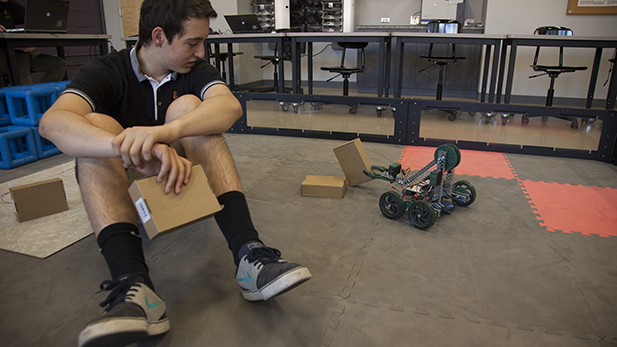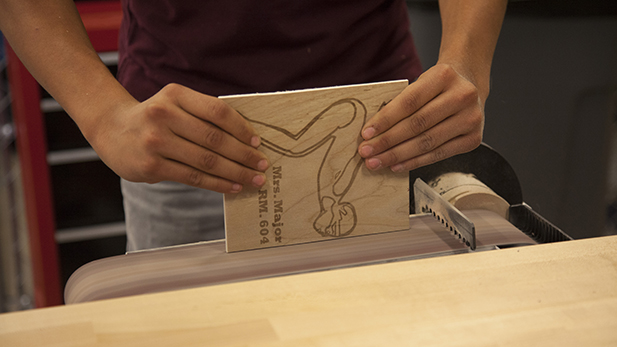 Freshman Katie Hicks welds at the Cracchiolo Family Science Technology Engineering and Mathematics Center on April 23, 2015.
Freshman Katie Hicks welds at the Cracchiolo Family Science Technology Engineering and Mathematics Center on April 23, 2015. Listen:
Catholic schools in Southern Arizona are reversing a years-long drop in enrollment and bucking a national trend of fewer students going to church-affiliated schools.
“Two years ago we leveled off and then last year we had an increase in both elementary and high school,” said Sheri Dahl, the Superintendent of Catholic Schools for the Diocese of Tucson.
The network counts about 6,600 students, which includes those at schools in Tucson, Yuma, Sierra Vista and other parts of southern Arizona. Students take religious classes, such as theology, but there is also an increased focus on helping students become workforce ready.
Two Tucson Catholic high schools, Salpointe and San Miguel counted larger student bodies this year than the previous year. In Salpointe’s case, a robust freshmen class stemmed a seven-year decline.
Schools say one reason for the growing population is Arizona’s tax credit and educational empowerment scholarship programs, which allow public dollars to be used for a private education.
Another? Curriculum and classes that put students in law firms and banks as employees or at the helm of drones and built-from-scratch robotics.
“We need students who can problem solve, who can communicate, who can collaborate and who can think critically,” said Salpointe President Kay Sullivan.
At San Miguel High School the message is similar.
“Our students need to be employable,” said Director of Admissions Francisco Moreno.
 A freshman student watches his classmate Quentin Romanoski maneuver a robot at Salpointe High School's STEM center.
A freshman student watches his classmate Quentin Romanoski maneuver a robot at Salpointe High School's STEM center. Robots, drones and 3-D printing in the classroom
Salpointe Freshman Quentin Romanoski’s schedule includes typical core classes– English, theology and math. He also spends part of the day learning to build and program robots.
“You go from soldering motherboards, which are electrical to building machines and using machines,” Romanoski said.
He puts a green four-wheeled robot through its paces, picking up cardboard boxes and weaving S-shaped patterns in a practice arena.
The robot ring is one feature of Salpointe’s 8,000-square-foot Science Technology Engineering and Math center, opened in January.
The space that was once the school’s library is now home to a 3-D printer, laser engraver, and numerous other high-tech tools. The center was funded by donors to the school and part of a $12 million improvement project that also included a student center.
“We visited corporate leaders, groups in town, political leaders, economic leaders– basically what they said is we need an educated workforce,” Sullivan said. “The weakness we had was in our science, technology, engineering and math facilities.”
 A student sands hall passes designed by his peers and created with a laser engraver.
A student sands hall passes designed by his peers and created with a laser engraver. Teachers said the center will allow them to add new classes such as intermediate robotics, biotechnology and environmental engineering.
“This is offering students an opportunity to actually touch what engineers do, to think like an engineer, to problem solve like an engineer,” said Jason Hastings, a teacher and department chair for career and technical education.
Julia Wilkinson said taking classes in the STEM center has sharpened her focus to become an engineer.
“In this class we get to do what we want, we have our own creativity,” Wilkinson said as she watched the laser engraver etch designs into a wooden hall pass. “It think it takes a lot more brainpower to be in this class.”
‘Secret Sauce’ at San Miguel High School
San Miguel High School opened on Tucson’s south side in 2004, more than 50-years after national enrollment in Catholic schools peaked in the country.
“We started at Santa Monica Church with only two classrooms,” said Moreno, the director of admissions. “Now we have more than 40 classrooms. The community has really embraced us.”
Moreno said the school has increased enrollment each year since opening. About 35 percent of students come from private schools, the rest from public schools.
Once they get to San Miguel, 100 percent of students have a job.
They spend nine hours a day, four days a week in the classroom. On on the fifth day, they go to work.
The student’s salary goes directly toward paying their tuition, overall, it accounts for about 40 percent of funding for each student. Donor contributions and tax credit designations pay for the next largest portion.
Students work in a variety of jobs in fields including healthcare, law and human resources.
“I tell people that’s the secret sauce with what happens with the students because once they experience the real world and they’re working with mentors...something clicks in their mind. ‘Hey I could do this,’” Moreno said.

By submitting your comments, you hereby give AZPM the right to post your comments and potentially use them in any other form of media operated by this institution.